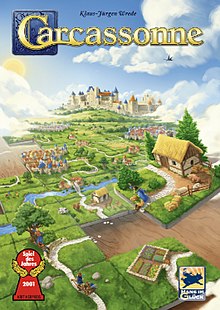Carcassonne (board game)
 |
|
| Designer(s) | Klaus-Jürgen Wrede |
|---|---|
| Publisher(s) |
Hans im Glück (Germany) Z-Man Games (UK, US) 999 Games (Netherlands) Фантасмагория (Bulgaria) Lautapelit.fi (Finland) Κάισσα (Greece) Brain Games (Estonia, Latvia, Lithuania) メビウスゲームズ (Japan) Giochi Uniti (Italy) Piatnik Budapest Kft. (Hungary) Devir (Spain, Portugal) Grow (Brazil) MINDOK (Czech Republic, Poland) Rio Grande Games (Sweden) Hobby World (Russia) |
| Genre(s) | Tile-based |
| Players | 2–5 (6–8 with expansion) |
| Age range | 8 + |
| Setup time | 1–5 minutes |
| Playing time | 30–90 minutes |
| Random chance | Medium |
Carcassonne is a tile-based German-style board game for two to five players, designed by Klaus-Jürgen Wrede and published in 2000 by Hans im Glück in German and by Rio Grande Games (until 2012) and Z-Man Games (currently) in English. It received the Spiel des Jahres and the Deutscher Spiele Preis awards in 2001.
It is named after the medieval fortified town of Carcassonne in southern France, famed for its city walls. The game has spawned many expansions and spin-offs, and several PC, console and mobile versions. A new edition, with updated artwork on the tiles and the box, was released in 2014.
The game board is a medieval landscape built by the players as the game progresses. The game starts with a single terrain tile face up and 71 others shuffled face down for the players to draw from. On each turn a player draws a new terrain tile and places it adjacent to tiles that are already face up. The new tile must be placed in a way that extends features on the tiles it touches: roads must connect to roads, fields to fields, and cities to cities.
After placing each new tile, the placing player may opt to station a piece (called a "follower" or "meeple") on a feature of that newly placed tile. The placing player may not use a follower to claim any features of the tile that extend or connect features already claimed by another player. However, it is possible for terrain features claimed by opposing players to become "shared" by the subsequent placement of tiles connecting them. For example, two field tiles which each have a follower can become connected into a single field by another terrain tile.
The game ends when the last tile has been placed. At that time, all features (including fields) score points for the players with the most followers on them. The player with the most points wins the game.
During the players' turns, cities, cloisters, and roads (but not fields) are scored when they are completed—cities and roads when they are completed (i.e. contain no unfinished edges from which they may be expanded), and cloisters when surrounded by eight tiles. At the end of the game, when there are no tiles remaining, all incomplete features are scored. Points are awarded to the players with the most followers in a feature.
...
Wikipedia
